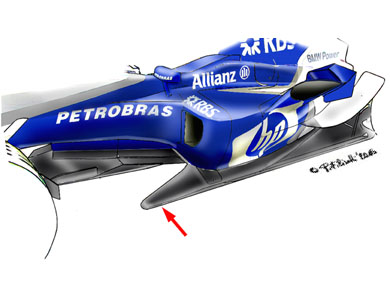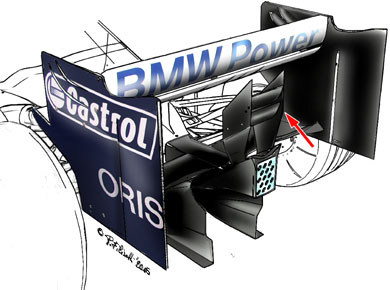Monday, March 07, 2005
OZ GP 2005 TECHNICAL ANALYSIS
This wing coupled to the very well refined profile of the sidepods has made the RB01 much more stable in comparison to its predecessor, the Jaguar R5. The deep spoon profile at the centre and the sinuous side sections provide a very good amount of downforce, notwithstanding the 2005 rules which require the front wing to be higher from the ground.
The most visible change on the Sauber in Melbourne is a new engine cover which features a sort of vertical fin on its top, so as to direct the air flow to the rear wing more efficiently. The Renault R24 was the first car to sport such a solution and other teams may yet follow the lead.

Ferrari F2004 M - new front-wing endplates
This design sports a flat, knife-edge profile instead of the curved section that was seen during pre- season testing. This change improves the efficiency of the front wing and reduces the turbulence generated by the front wheels.

Williams FW27 - new turning vanes
Gone are the horizontal fins attached to the central part of the car's stepped bottom. Instead they have morphed into pointed extensions to the sidepods, almost resembling a knife blade. These vanes split the airflow in two, with the lower part directed to the bottom of the car, and the upper part diverted over the stepped bottom and around the lower section of the sidepod, adding a good amount of downforce.

Williams FW27 - additional bi-plane wing
Addition of a very small wing, 10 cm wide, right over rear light support. Features a double profile with very high wing inclination, so as to assure a small but effective amount of downforce. Could be used as soon as Saturday qualifying in Melbourne, but in general only likely to be adopted on slow twisty circuits where traction is paramount.

Toyota TF105 - additional winglets and profiles
Additional wing profile (1) has been placed on top-front edge of sidepod, similar to that last year on Jordan EJ14. Main purpose is to increase downforce in this area of the car, but also divides airflow coming from the front wing into two, aiding engine cooling slightly. Addition of small winglets (2) on top of flip ups ahead of rear wheels - show how crucial downforce is above rear axle level to improve the car's grip.

